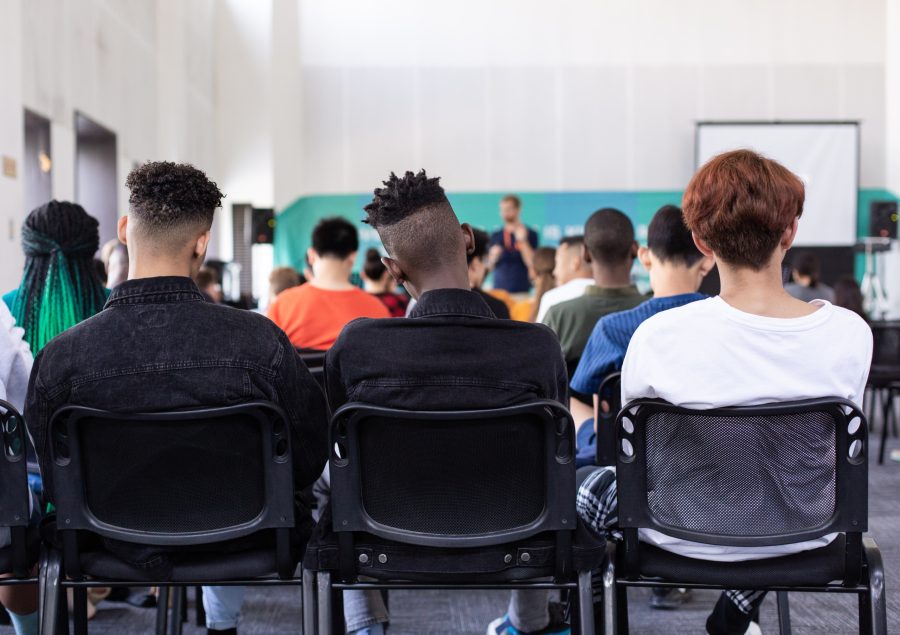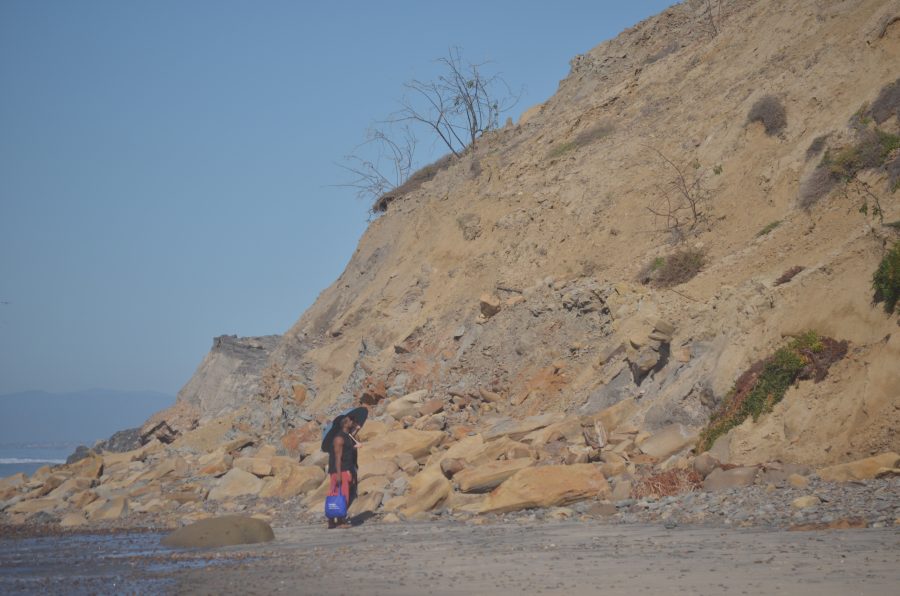New Building a Site of Both Student Needs and Wants
By Daniel Palay, Chair of the Athletics, Recreation & Sports Facilities Advisory Board
The recent groundbreaking of the RIMAC Annex project has
been the subject of much discussion in this paper and in recent A.S. Council
meetings. But it seems that this is just the product of a few current
councilmembers whose narrow-minded vision of the university has darkened this
new facility’s prospects.
|
Related Links March 13, 2008 — "RIMAC Annex Center of Funding Debate" |
I have served as the student co-chair of the Athletics,
Recreation and Sports Facilities Advisory Board for the past three years.
ARSFAB was created in 2004 through a partnership between the A.S. Council, the
Graduate Student Association and the vice chancellor of student affairs to
address policy and budgetary matters of these departments, including capital
improvements. During this time, we have spoken on many occasions about the
RIMAC Annex, both about funding and the general layout of the facility. Our
student members take their roles seriously and participate fully in these
discussions.
First, some facts: RIMAC — the Recreation, Intramurals and
Athletics Complex — was designed between 1988 and 1991 to replace Main Gym,
which is maintained completely by the university and does not use student
funds. RIMAC was conceived as a hub for both recreation and intercollegiate
athletics. It was designed to hold an arena, weight rooms, high- and low-impact
activity rooms and racquetball, squash and basketball courts. All of these
things can be found in the current structure, which is nearing its 15th
anniversary. The original plans called for additional conference-room space —
far more than is currently available, and various food service and dining
facilities. The latter two, along with proposals for hot tubs and saunas, a
rock-climbing center and an outdoor resource center, were left out of the
original building due to budgetary concerns.
In various student surveys submitted since the opening of
RIMAC, including a 1997 Quality of Student Life Survey and last winter’s survey
during the special election, students have overwhelmingly supported the idea of
expanding the lounge and meeting-room spaces. Today, demand for meeting room
space remains high. Additionally, students continually supported expanded
activity-room space.
So, I find myself perplexed as to what the problem with the
RIMAC Annex is. Is it because a very small minority — including one member who
is no longer on the board — has suddenly taken the cause to the student
government because ARSFAB continually ruled against him by a large consensus?
Is it a student government that has taken new meaning to the expression of
having a bark bigger than its bite? Or is it that the opposition simply doesn’t
like the idea of something athletics-related — not intercollegiate athletics —
because in its mind, the athletics program has already gotten its fair share.
As a veteran of campus politics, I think this situation oozes
with the marks of all three of these possibilities. Even as the opposition
tried to drum up support from other ARSFAB members at the past council meeting,
his arguments were refuted by one of our GSA members, who could not recollect
any controversy surrounding the RIMAC Annex since his appointment in winter
2007.
As chair of these meetings, I was not surprised when our
argument of student satisfaction with the proposed project was substantiated;
it was strike one against the opposition’s argument.
Strike two came during the most recent A.S. Council meeting.
In the meeting, it was consistently argued that student input was not welcomed
— it has been argued several times in print also. Yet, a year ago, Sports
Facilities Director Don Chadwick addressed the council about the RIMAC Annex.
Based on the entire project portfolio , he explained that no new fees would be
assessed. Additionally, he made a special note to say that no new debt service
would be incurred. Combined with the aforementioned surveys and focus groups,
as well as ARSFAB and the student-run Building Advisory Committee, input was
both welcomed and received.
Convoluted questions asked during the meeting were meant to
verbally crucify Chadwick as a callous administrator with no stomach for
student input. Questions from President Marco Murillo, Associate Vice President
of Academic Affairs Long Pham and President-elect Donna Bean focused on the
annex-related semantics. In their minds, recreation is limited to
sports-related activities. This is not surprising, coming from a council that
has seen its biggest debates center around Triton Tide and screen printing.
However, their arguments were negated by one of their very
own. In a response to a question by Pham about what was considered recreation,
I told the council that the UCSD Recreation Department offers a class on how to
play poker. I figured certainly we could agree that poker is not considered a
sport in the traditional sense. But a vocal Vice President of External
Relations Dorothy Young reminded me that poker exercises the mind (not to
mention that poker appeared on ESPN — a station that also airs the Scripps
National Spelling Bee). So if the council’s definition of recreation is
anything that exercises mind, body or soul, certainly they should not have any
problems with the amenities in the annex.
Let’s see. The annex’s convenience store will stock protein
drinks and bars, organic fruits and juices and various other health-related
products. I think we can agree that this would benefit the body, especially
after utilizing RIMAC’s facilities. The cafe will feature a health-food theme,
while at the same time is open to having access to beer and wine service — and
certainly after a hard day at work a drink is not totally unwarranted for the
mind and soul to unwind. Better yet, a daily glass of red wine has been shown
to lower the risk for heart disease.
And finally, the lounge space and conference room, which are
equipped with wireless Internet, provide students, teams and student
organizations areas to do their work and conduct their meetings. I think we can
safely assume that these areas also point to a desire to allow for the
exercising of one’s mind.
I think that these are pretty straightforward answers to the
mental blocks that the four or five people asking questions had. But to my
astonishment, questioning continued for two hours and became rather repetitive,
with every question having a hint of trying to trap Chadwick into saying
anything that the inquirer could construe as disregarding student opinion.
The main concern that most students have with RIMAC is the
lack of adequate workout equipment and activity-room space. This was a point
argued ad nauseam by the A.S. Council, in regard to the annex not containing
any of these features. First, this statement is a misnomer, as the annex does
provide for a conference/team room, which will be used for low-impact
recreational classes such as yoga and massage. Secondly, ARSFAB is planning
additional activity, weight and cardio space spaces in existing facilities.
In RIMAC, an additional 32 pieces of cardiovascular
equipment — to be added by next fall — will be put where the racquetball
seating currently exists. Additionally, there are plans to build an activity
room and expand the weight room at Spanos Athletic Training Facility in order
to serve as a varsity athlete training area, thus freeing up the pit for
general use.
And in the near future there will be renovations at the Main
Gym to accommodate more weight and activity-room spaces. Combine these
advancements with the newly opened Wellness Studio and all of the concerns of
the small minority on the A.S. Council will be addressed even before the annex
is set to open its doors. I believe this is strike three.
And as ARSFAB chair, I can’t see how going through these
processes on a student-dominated board would be anything less than student
input. I would stand by the student voice on this aspect for as long as the
building will allow current and future students to enjoy its amenities.
Process of Bringing About Annex Left Students’ Opinions by the Wayside
By Dana Dahlstrom, Former Member of the Athletics, Recreation & Sports Facilities Advisory Board 2005-07
It’s almost uncomfortable to watch proponents of the RIMAC
Annex contort themselves into pretzels as they struggle to justify the project,
an unenviable task considering the problems they have to surmount. The project
involves spending millions of students’ recreation-fee dollars on retail
outlets instead of facilities for exercise and sports. It was conceived,
planned and undertaken by a handful of administrators long before students were
involved. And finally, when the project came to students’ attention and they said
they wanted more cardio machines and weight rooms instead of a convenience
store and a cafe, students were frustrated in their efforts to effect any such
changes. None of this looks very good.
Misgivings about the annex project are not mine alone — and
they are not new. Every A.S. president since Jenn Pae in 2004 has shared
similar concerns, as has every president of the Graduate Student Association
since Kris Kohler the same year. I have worked with all eight of these student
leaders trying to convey the common-sense notion that students’
recreation-facility fees are for recreation facilities.
Usually, major construction funded by student fees requires
a referendum, but because RIMAC fees generate a large surplus, administrators
can afford a whole new building without asking students. Almost $5 million in
accumulated RIMAC reserves are earmarked for the annex, and the rest will be
borrowed against future fees. When student fees exceed the needs for which
they’re collected, students should be involved in an open process to determine
how to spend the money or, alternatively, whether to decrease the fee.
The RIMAC fee was established by a 1990 referendum that
stated “decisions regarding funding of [RIMAC] must be discussed / reviewed
with the Registration Fee Committee,” but by the time the committee was
consulted the RIMAC Annex project was nearly three years underway and had
already drawn on RIMAC fees for its planning and design. The cafe had been part
of the plan since 2002, but administrators didn’t discuss this decision with
the Registration Fee Committee until February 2005.
In their first meeting concerning the RIMAC Annex, students
on the Registration Fee Committee asked commonsense questions: When there is “a
wait list for the aerobics machines […] how come we’re not buying more
exercise machines, and how come we’re building a cafe?” They told the
sports-facilities director that “the main concern with RIMAC is the need for
additional exercise equipment.” Another student said, “there’s a distinction between
something that you want to be built at some point and something that you want
to be built with funds that are set aside for recreational purposes.” Committee
members commented that it seemed not so much an annex to RIMAC as “an extension
of the
The Registration Fee Committee wrote to the vice chancellor
of student affairs expressing concern that students weren’t involved in the
planning, that the project wouldn’t serve any athletic purpose and that it
didn’t address student demand for exercise space and equipment. But students’
thoughtful input, three years into the project, had little impact on
administrators’ course of action.
The Registration Fee Committee also pushed for the creation
of a student board to oversee the RIMAC fee and facility. As I’d discussed with
presidents Pae and Kohler, since RIMAC was built using student fees, UCSD
policies required that the campus establish a student-led board with
jurisdiction including capital improvements. So this combined effort, growing
partly out of the RIMAC Annex issue, led to the creation of the Athletics,
Recreation and Sports Facility Advisory Board in 2005. I declined requests to
run for student co-chair; instead, I invited Daniel Palay to the next meeting
and nominated him for the position, since I knew him as an outspoken A.S.
senator and a student athlete.
But ARSFAB as a board never did examine the RIMAC Annex as I
and the other advocates for its creation had intended it to do. We did little
but listen to lengthy area updates from the three respective directors of
sports facilities, athletics and recreation programs. I took every opportunity
to relay concerns about the RIMAC Annex and suggest it contain exercise
equipment, but the administrators on the board responded in a mostly dismissive
manner and told us we wouldn’t make decisions about the project since a
building advisory committee for the annex had been formed more than a year
before ARSFAB.
In Jan. 2007, I worked with the A.S. and GSA presidents to
write a survey for students to answer through TritonLink specifying what they
wanted in the RIMAC Annex. Over 7,500 students responded and, not surprisingly,
voted for activity rooms, weight rooms and cardio equipment over a convenience
store or cafe. At the Feb. 27 ARSFAB meeting we presented the results clearly
ordered by priority, but this led to the same place as most other board
discussions: nowhere.
Administrators should have based the project details on
student input, but instead they made all the important decisions without meaningful
student participation. They did eventually delegate to ARSFAB one decision
about the RIMAC Annex: whether or not alcoholic beverages would be sold there.
This led one board member to remark that ARSFAB’s role was more to “choose the
color of lipstick than the pig.”
The RIMAC Annex project has been a glaring example of
student disempowerment, but it isn’t beyond hope. Retail in north campus may be
needed, but a cafe and a convenience store ought not to be built with
recreation-facility fees nor operated by the sports-facilities unit. If we want
to keep student fees under control and help maintain our university’s
reputation as a leader in practicing shared governance, we have to play an
active role making sure stakeholders’ money, our money, is spent appropriately.
If you’re interested in more detail and history, visit
fees.ucsd.edu/rimac-annex for documentation especially regarding student input
in the project. If you want to get involved, contact your A.S. or GSA
representatives. And if you really want an earful about student rights, get in
touch with me directly; I’m generally happy to oblige.







